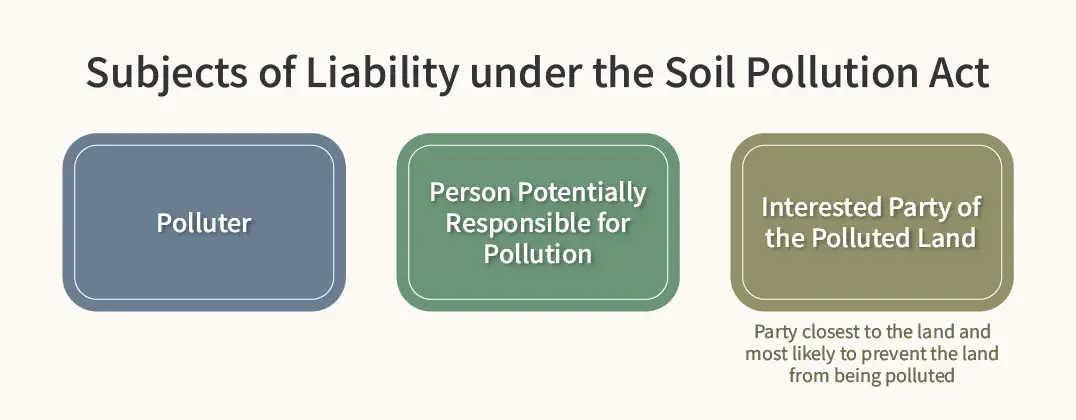 Soil and Groundwater Pollution Remediation Act
Soil and Groundwater Pollution Remediation Act
The "Soil and Groundwater Pollution Remediation Act" (hereinafter referred to as "the Act") was promulgated on Feb. 2, 2000, with eight chapters and 51 articles. It regulates in detail the prevention, control, remediation and rehabilitation measures, of soil and groundwater pollution, as well as relevant finances and responsibilities. Later, in response to the promulgation of the "Administrative Procedure Act," it was amended and promulgated on Jan. 8, 2003. Considering that, since the Act's promulgation and implementation ten years prior in 2000, the types and numbers of pollution sites had increased yearly as pollution investigations were conducted, while relevant works had become increasingly complex, to ensure the original intent of the legislation and review and respond to issues and needs that had arisen after the Act's implementation, on Feb. 3, 2010, the Act was amended and promulgated. Currently, there are eight chapters and 57 articles, reflecting Taiwan's changing pollution realities.
- General Principles: definitions and competent authority jurisdictions.
- Preventive Measures: regular testing (monitoring), verification and necessary pre-listing response measures, soil pollution evaluation, investigation, and testing data submission, engineer certification.
- Investigation and Assessment Measures: pollution investigation, sediment control, site public listing, site investigation and pollution control.
- Regulatory Measures: necessary response measures, designation and restriction of control areas, registration of transaction prohibition.
- Remediation and Restoration Measures: submission of remediation plans, formulation of remediation goals, delisting.
- Financing and Responsibility: establishment of remediation fund, source of levy, usage.
- Penal Provisions: penalty rules for violations of the Act.
- Supplementary Provisions: collateral damage reparations, retrospectivity.
The draft amendment to the Act was approved by the Executive Yuan in 2007 and then submitted to the Legislative Yuan for review. After multiple discussions in 2008, the Legislative Yuan completed the third reading on Jan. 8, 2010, and the amendment was promulgated by the president on Feb. 3. The amendments include:
- Including sediment in the scope of regulation, adding monitoring and remediation responsibilities for sediment.
- Expanding the scope of responsibilities for the person potentially responsible for pollution.
- Reinforcing responsibility requirements for the party of the polluted land.
- Reinforcing monitoring requirements for high-pollution potential areas.
- Introducing deadlines for necessary resopnse measures to be taken and criteria for regulations for delisting.
- Revising requirements for businesses to provide soil pollution assessment data.
- Reinforcing the management of land auction suspension procedures.
- Introducing an engineer certification system and risk assessment mechanism.
- Expanding the funding base for the pollution remediation fund and allocating a specific portion of funds as budget for environmental education.
- Increasing penalties and responsibility requirements for polluters.
The goal is to improve the mechanism for soil and groundwater pollution remediation and reinforce oversight and responsibility for polluters.

Key measures for enhancing environmental protection regulations and advancing pollution remediation efforts include:
Expanding the scope of regulation: including sediment in soil pollution control, making Taiwan's pollution prevention, control, and remediation more comprehensive, while improving the legal framework for environmental protection.
Reinforcing monitoring of high-pollution potential areas: aiming to prevent soil and groundwater pollution, while prompting competent authorities to focus on environmental quality.
Expanding the range of responsible parties for pollution sites: adding a mechanism to identify the person potentially responsible for pollution, encouraging more careful practices by land users and ensuring optimal protection of limited environmental resources.
Promoting the engineer certification system: strengthening the professional framework for environmental engineering and raising professional standards.
Establishing a reimbursement claiming mechanism for remediation expenses: holding company directors, controlling companies, or majority shareholders accountable to prevent evasion of responsibility for pollution through corporate structures.
The vision is primarily aimed to protect soil and groundwater resources and ensure remediation efforts are carried out smoothly. Main features include:
- Focus on pollution remediation to avoid regulatory overlap and conflicts in enforcement.
- Information transparency adoption, establishing channels for public participation.
- Implementation of a dual-threshold system to facilitate practical remediation efforts.
- Establishment of the Soil and Groundwater Pollution Remediation Fund to support pollution site control and remediation operations.
- Promotion of the integration of pollution remediation with land development activities.
- Enforcement of the "polluter pays" principle.
Meaning a person causing soil or groundwater pollution through any of the following acts:
- Leaking or discarding of pollutants.
- Illegally discharging or injecting pollutant.
- Brokering or allowing the leaking, discarding, illegal discharge or injection of pollutant.
- Disposing pollutants against the provisions of law or regulations.
Meaning a person who causes pollution to accumulate in the soil or groundwater resulting in soil or groundwater pollution due to the following actions:
- Discharging, injecting, permeating of pollutants.
- Permitting or consenting to the discharge of waste water into irrigation-drainage systems or irrigation water catchment areas.
Meaning a person who is not a polluter of the land but is a user, administrator, or owner of the land when the land is publicly announced a pollution control site or a pollution remediation site.
Meaning a place where the source of soil or groundwater pollution has been clearly identified and the pollutants therein do not naturally exist in the environment but have resulted from scouring by water, dispersal, deposition, or irrigation causing soil or groundwater pollution that meets the control standards.
Meaning a pollution control site which has been reviewed and publicly announced by the central competent authority as such a site based on its preliminary assessment that the site is likely to seriously endanger public health and the living environment.
- Data Source: Soil and Groundwater Pollution Remediation Fund Management Board
- Publish Date: 2024-11-28
- Update Date: 2025-11-27

 Related Topics
Related Topics



